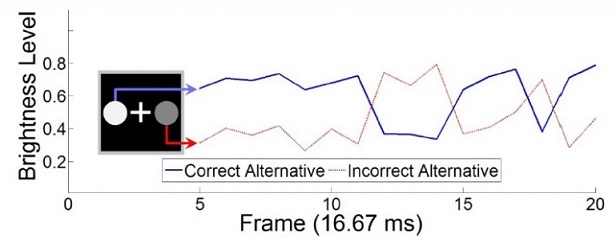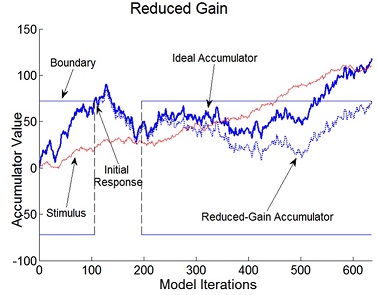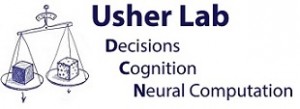The algorithm of evidence integration in perceptual decisions and judgments of confidence
One stream of research involves the nature of the mechanism by which people integrate noisy evidence and reach a decision. The goal here is to account for both choice and RT-distribution data. We do this by manipulating relevant variables, such as the flow of evidence, task requirements, etc., and we fit the data with competing neurocomputational theories.

Illustration of the stimuli: On each trial, one of the disk’s brightness level stochastically dominated the other; B) Experimental design: In the first experimental session, observers were instructed to choose the dominating disk. After making a decision, additional information was presented for at least 1.5 seconds. Hereafter observers could either confirm, or change their decision (t2).
The results indicate that the decision-mechanism is efficient (subject to response-competition) and adaptive (observers adapt the nature of the integration to the environmental contingencies). We also find that people keep integrating evidence even after they make decisions and that this contributes to their decision-confidence. Interestingly, the gain of the post-decisional information is reduced (less efficient integration, see Figure 1), accounting for commitment effects (cases in which decision-makers are less likely to change their mind, even in face of contradictory evidence).

Figure 1. Illustration of the reduced-gain drift-diffusion model, in which sensitivity to additional information is reduced following a decision (from Bronfman et al., 2015. Decisions reduce sensitivity to subsequent information. Proceedings of the Royal Soc. London, B.)
A behavioral algorithm to monitor the decision boundaries, which shows that people integrate evidence to a collapsing boundary, and that they have a bias favoring evidence samples that are consistent with preceding evidence samples:
- Moshe Glickman's new paper in Nature Human Behaviour: Evidence integration and decision confidence are modulated by stimulus consistency
Are decision mechanisms sensitive to absolute or relative variables?
Relative processing is the canonical assumption in cognitive psychology (diffusion models) and in neuro-economics (normalization models). Our results, however, indicate that both the decision mechanism is sensitive to both relative and absolute values of the alternatives (see new paper: Teodorescu AR, Moran R & Usher M. (2015). Absolutely relative or relatively absolute: violations of value invariance in human decision making. Psychon. Bull & Review.
Decision confidence
What determines decision confidence and its resolution -- the fact that confidence is higher for correct vs incorrect responses-- ? A recent work on this topic is: Moran R, Teodorescu AR & Usher M. (2015). Post choice information integration as a causal determinant of confidence: Novel data and a computational account. Cognitive Psychology 78 (2015) 99–147. (PDF: Conf-Rani.pdf)
- David's new paper in Psych Sci (2021): The Cognition/Metacognition Trade-Off (shows that while integration-to boundary is optimal for making decisions, it has a cost in metacognitive performance, because it has little variability across trials to indicate choice accuracy: It also shows that integration to collapsing boundary achieves a compromise to optimize a combination of choice accuracy and meta_cognitive performance)
Violations of rationality
Human choice behavior is also subject to a number of puzzling choice patterns that contradict axioms of rationality. For example, people show contextual preference reversal in their decisions: A person may prefer A over B in a binary choice, but will prefer B over A, when a decoy (D), which is similar yet inferior to B is added to the choice-set. Also, people sometime violate the transitivity principle: they prefer B to A, and C to B, but also A to C. Our research has led to a number of explanations (see the selective-integration model) for these choice patterns, and also provides a potential solution to the paradox of irrationality. Some of the work on this can be found in this papers:
Tsetsos K, Chater N & Usher M. (2012). Salience driven value integration explains decision biases and preference reversal. Proceedings of the National Academy of Sciences of the United States of America, 109, 24, 9659-9664
Tsetsos K, Moran R, Moreland J, Chater N, Usher M, & Summerfield C. (2016). Economic irrationality is optimal during noisy decision making. PNAS.
Glickman M, Tsetsos K & Usher M (2018). Attentional Selection Mediates Framing and Risk-Bias Effects. Psychological Science.
Usher M, Tsetsos K, Glickman M & Chater N (2019). Selective Integration: An Attentional Theory of Choice Biases and Adaptive Choice. Current Directions in Psychological Sciences.
